 I started reading nautical fiction, specifically C.S. Forester’s Hornblower series, as a teenager. The Hornblower novels, while meant for adults, were great “boy books,” full of adventure and action, with a hero with just enough self doubt and angst for a teenager to relate to. The readers of most nautical fiction seem to be primarily boys and men, which is not surprising for a genre whose heroes and villains are overwhelming male. Is there room for female readers and indeed a female heroine in these crowded waters? And if so, what role could she and would she play? After reading Linda Collison’s novel, Star-Crossed, the answer to the first question is clearly yes.
I started reading nautical fiction, specifically C.S. Forester’s Hornblower series, as a teenager. The Hornblower novels, while meant for adults, were great “boy books,” full of adventure and action, with a hero with just enough self doubt and angst for a teenager to relate to. The readers of most nautical fiction seem to be primarily boys and men, which is not surprising for a genre whose heroes and villains are overwhelming male. Is there room for female readers and indeed a female heroine in these crowded waters? And if so, what role could she and would she play? After reading Linda Collison’s novel, Star-Crossed, the answer to the first question is clearly yes.
Continue reading
In June we posted about ships using SkySails to reduce fuel costs by an estimated 10 to 35%. (See Go Fly a Kite? A Look at SkySails) One possibly unforeseen hazard of the SkySails became clear last week when an aircraft and a Skysail deployed from a ship had a close encounter.
 On Sept. 20, 1519, Portuguese navigator and explorer Ferdinand Magellan and his crew set out from Spain on five ships on a voyage to find a western passage to the Spice Islands in Indonesia. (Magellan was killed en route, but one of his ships eventually circled the world.)
On Sept. 20, 1519, Portuguese navigator and explorer Ferdinand Magellan and his crew set out from Spain on five ships on a voyage to find a western passage to the Spice Islands in Indonesia. (Magellan was killed en route, but one of his ships eventually circled the world.)
 While New York may have a great yearly tug boat race, I recently discovered that Halifax harbor has a real Theodore Tugboat.
While New York may have a great yearly tug boat race, I recently discovered that Halifax harbor has a real Theodore Tugboat.
In the 1990s, “Theodore Tugboat”, was a Canadian kid’s TV show about a harbor tug in the “Big Harbor”. In the late 90s it was picked up by US television. Using radio controlled model tugs, it was sort of a maritime “Thomas the Tank Engine“.
In 2000, a 65 foot harbor tug, the Theodore Too, was built in Halifax. It is a full-size replica of the scale model of the tug used in the original series. Theodore Too is currently operated as harbor tour boat – Tour the Big Harbor.
Continue reading
Well it is that time of year again. In honor of International Talk Like a Pirate Day ….
Spare me the lame” arrgghs” and “shiver me timbers”. If you want to talk like a budhcad badeed (Somali for pirate) show some effort.
Or if you want to be old school, looking back to the 90s when the Straits of Malacca were a pirate hot spot, you could also try Bahasa Indonesian, which is a bit easier. “Tarik, kau penyakit kudis anjing” (according to Google) means “heave to, you scurvy dog.”
It is also the start of the Jewish New Year. So far, I haven’t figured out how to say Happy Rosh Hashanah in Somali.
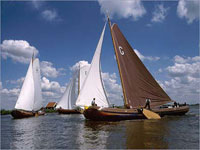 Following up on our previous posts – Dutch Barges invade New York and The Dutch Barge Fleet has Arrived in New York. From the AP:
Following up on our previous posts – Dutch Barges invade New York and The Dutch Barge Fleet has Arrived in New York. From the AP:
Dutch flotilla makes its way north on Hudson River
A flotilla of historic Dutch sailing ships is making its way up the Hudson River to mark this month’s 400th anniversary of Henry Hudson’s voyage aboard the Half Moon.
Continue reading
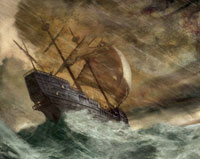 The October 2009 National Geographic magazine has a fascinating story of a 16th century shipwreck on a beach in southern Namibia. In 1533 a Portuguese trading ship carrying a fortune in gold and ivory, bound for the famed spice ports of India, was swept ashore and wrecked by a winter storm. It lay undisturbed until it was discovered only last year. Ironically, the treasure laden ship, believed to be the nau Bom Jesus, wrecked on a beach rich with diamonds. The wreck was discovered in the Sperrgebiet, the Forbidden Zone, the fabulously rich and strictlyoff -limits De Beers diamond-mining lease near the mouth of the Orange River on Namibia’s southern coast.
The October 2009 National Geographic magazine has a fascinating story of a 16th century shipwreck on a beach in southern Namibia. In 1533 a Portuguese trading ship carrying a fortune in gold and ivory, bound for the famed spice ports of India, was swept ashore and wrecked by a winter storm. It lay undisturbed until it was discovered only last year. Ironically, the treasure laden ship, believed to be the nau Bom Jesus, wrecked on a beach rich with diamonds. The wreck was discovered in the Sperrgebiet, the Forbidden Zone, the fabulously rich and strictlyoff -limits De Beers diamond-mining lease near the mouth of the Orange River on Namibia’s southern coast.
Read the article: Diamond Shipwreck – Shipwreck in the Forbidden Zone
Photo Gallery of the wreck site
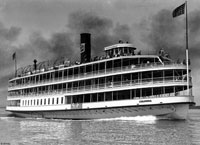 SS Columbia, built in 1902, is the oldest surviving passenger steam vessel in the United States. The SS Columbia Project is dedicated to restoring and operating the classic passenger steamer. They are holding their first official fundraising event tommorrow featuring a cruise on the Detroit River on board the M.V. Friendship. Complimentary pizza, delivered by the J.W. Westcott II mailboat, will be served and a cash bar will be available.
SS Columbia, built in 1902, is the oldest surviving passenger steam vessel in the United States. The SS Columbia Project is dedicated to restoring and operating the classic passenger steamer. They are holding their first official fundraising event tommorrow featuring a cruise on the Detroit River on board the M.V. Friendship. Complimentary pizza, delivered by the J.W. Westcott II mailboat, will be served and a cash bar will be available.
From the SS Columbia Project :
Continue reading
Australian adventurer and solo round the world sailor, Don McIntyre announced today that Mike Perham, the world’s youngest solo circumnavigator, has signed up as Second-in-command for the 2010 Bounty Boat Expedition. This is a 4,000-mile re-enactment 221 years after Capt William Bligh and his supporting crew were forced into an open-boat by the mutineering crew on HMS Bounty and successfully sailed from Tonga to Timor in the Pacific.
McIntyre and Perham will face the same deprivations, with little food, no charts or toilet paper and only the limited navigation implements that were available to Bligh.
The search is now on for two extra crew to join this expedition, which has a serious scientific purpose, as well as raise money for MND research. This opportunity of a lifetime to re-create history will cost each individual £10,000 to participate. Only those with an extreme sense of adventure need apply.
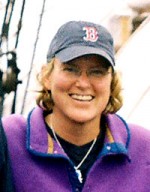 Sad news regarding a a remarkable woman and sailor.
Sad news regarding a a remarkable woman and sailor.
Amanda Ridgely Lake died in her home in Fairhaven, MA on August 19. Ms. Lake was 44. Ms. Lake was only one of a handful of women to ever earn a 100-ton Near Coast Master’s License, allowing her to pilot large vessels in and out of commercial ports. At the time of her death, she taught classes on advanced ship-handling and maritime safety at the Massachusetts Maritime Academy to help others achieve similar licenses. An accomplished sailor of all size ships, Ms. Lake served as Chief Mate and in various other positions aboard the Massachusetts tall ship Ernestina. After age and funding cuts forced the 115-year-old schooner dockside in 2003, she joined the crew of Pete Seeger’s Hudson Sloop, Clearwater.
A memorial service will be held for Ms. Lake on the deck of the schooner Ernestina on Saturday, Sept. 19, at 2:00 pm in New Bedford, MA.
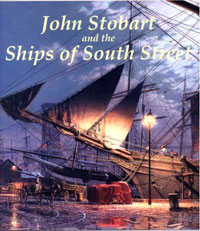 Last year the National Maritime Historical Society (NMHS) published a fascinating booklet, John Stobart and the Ships of South Street, which features the pre-eminent maritime artist’s paintings of ships arriving or departing from New York’s South Street docks.
Last year the National Maritime Historical Society (NMHS) published a fascinating booklet, John Stobart and the Ships of South Street, which features the pre-eminent maritime artist’s paintings of ships arriving or departing from New York’s South Street docks.
At first the presentation struck me as odd. The NMHS describes it as a booklet rather than a book, which is apt, as it is soft cover and only twenty four pages. John Stobart’s work is best enjoyed at full size. The prints of his paintings are breathtaking and worthy of study for their technical accuracy as well as his skillful composition and his breathtaking use of light and shadow. Can such a slight volume do Stobart’s work justice? After a few minutes of study, it became clear to me, that it can and indeed does.
Continue reading
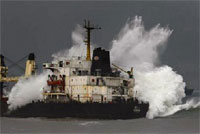 Lee shores were long the bane of sailing ships. They are no better for motor vessels who lose their engines or drag their anchors. Table Bay where the SELI 1 grounded is just such a lee shore and has been a hazard for ships for hundreds of years. An interesting perspective from Ports & Ships Maritime News – Table Bay as a lee shore – the grounding of the SELI 1 and other similar incidents.
Lee shores were long the bane of sailing ships. They are no better for motor vessels who lose their engines or drag their anchors. Table Bay where the SELI 1 grounded is just such a lee shore and has been a hazard for ships for hundreds of years. An interesting perspective from Ports & Ships Maritime News – Table Bay as a lee shore – the grounding of the SELI 1 and other similar incidents.
Continue reading
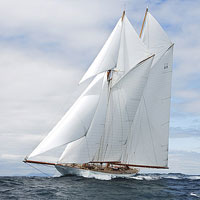 “Super yachts” rarely impress me. Russian billionaire, Roman Abramovich’s megayacht, “Eclipse,” may be the largest private yacht now sailing but it is, to my eye at least, a bit boring. It may be over 550 feet long and cost a bazillion rubles, but so what?
“Super yachts” rarely impress me. Russian billionaire, Roman Abramovich’s megayacht, “Eclipse,” may be the largest private yacht now sailing but it is, to my eye at least, a bit boring. It may be over 550 feet long and cost a bazillion rubles, but so what?
The new Schooner Elena on the other hand is both breathtaking and a resurrected bit of history. The first Elena was built for New York’s Morton Plant in 1911 by Nathaniel Herreshoff. She was beautiful and the fastest yacht of her day, winning races for years including the 1928 Trans Atlantic King’s Cup from New York to Santander.
Continue reading
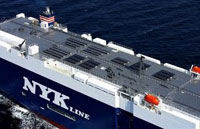
Solar Panels on the Upper Deck of the Augira Leader
After four voyages the solar panels on the upper of the NYK car carrier Auriga Leader have performed better than was expected but have also demonstrated how far there is to go in harnessing solar power.
The ship has generated 32,300 KW hours of electricity, the equivalent of seven months of electricity by 17 households in Japan, which was 1.4 times greater than that generated during land-based tests. Nevertheless, the electricity was the equivalent of only 0.05% of the ship’s propulsion power and 1% of its onboard electricity consumption.
Continue reading

Spotted Dick
The Aubrey/Maturin series of novels by Patrick O’Brian introduced the world to, among other things, a range of obscure traditional British cuisine, which notably included suet puddings such as “Floating Island”, the unappetizing “Drowned Baby” and the perennial favorite “Spotted Dick”. This week at a Flintshire council canteen in the UK, the traditional suet pudding “Spotted Dick” has been renamed “Spotted Richard” – because customers keep making jokes about the name. Outrage has ensued.
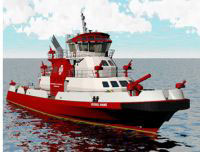 From Marine Log:
From Marine Log:
A fireboat launched September 11, 2009 at Eastern Shipbuilding, Panama City, Fla. is named the Three Forty Three in honor of the 343 New York City firefighters killed at the World Trade Center on September 11, 2001.
The Three Forty Three is expected to arrive in New York City in December and will be assigned to Marine 1, stationed on the Hudson River in Manhattan, replacing the 50-year-old John D. McKean.
The FDNY Marine Fleet consists of more than 30 vessels responsible for over 450 miles of coastline and harbors and has protected New York City residents for 134 years.
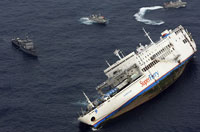 I’ve always been struck by the tragedy that those most in need of ferry service are often also most at risk. We have seen recent ferry accidents in the Philippines with the sinking of the Superferry 9 resulting in nine deaths, in Tonga with the loss of 73 passengers with the sinking of the Princess Ashika and earlier this year the deaths of an estimated 250 passengers when a ferry capsized near Sulawesi, Indonesia. Last year, MV Princess of the Stars, capsized in the Philippines with the loss of 800 lives.
I’ve always been struck by the tragedy that those most in need of ferry service are often also most at risk. We have seen recent ferry accidents in the Philippines with the sinking of the Superferry 9 resulting in nine deaths, in Tonga with the loss of 73 passengers with the sinking of the Princess Ashika and earlier this year the deaths of an estimated 250 passengers when a ferry capsized near Sulawesi, Indonesia. Last year, MV Princess of the Stars, capsized in the Philippines with the loss of 800 lives.
Barista Uno writing in the Marine Café blog in the Philippines has an intriguing perspective and insight on the sinking of the Superferry 9 and similar casualties:
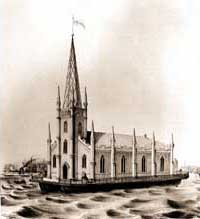 If you can’t get sailors to church, bring the church to the sailors. That was the strategy used in 1844 by the Protestant Church Missionary Society for Seamen, which was renamed the Seamen’s Church Institute. As they celebrate their 175th anniversary, it is a good time to remember the Floating Chapels of the Seamen’s Church Institute.
If you can’t get sailors to church, bring the church to the sailors. That was the strategy used in 1844 by the Protestant Church Missionary Society for Seamen, which was renamed the Seamen’s Church Institute. As they celebrate their 175th anniversary, it is a good time to remember the Floating Chapels of the Seamen’s Church Institute.
The Floating Chapel of our Savior for Seamen was built on the hull of a ferry boat. Originally moored at Whitehall Slip, it soon was moved to Pike Street on the East River in New York City. Services were held there from 1844 to 1866 when the chapel was deemed unseaworthy and replaced with another. The second chapel remained at Pike Street until 1910 when it was moved to Staten Island and taken ashore to become the All Saints Episcopal Church where it remained in use until it burned down the day after Christmas in 1958.
In 1846, only two years after the construction of the Floating Chapel on Pike Street, the Floating Chapel of the Holy Comforter was built and moored at the end of Dey Street where it remained until 1868.
The Seamen’s Church Institute of Philadelphia built its own Floating Church in 1848, the Floating Church of the Redeemer, which was in use for roughly ten years.
![]()
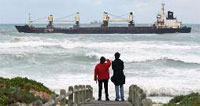
Seli-1 Aground off Cape Town
Last week was a bad week for bulk carriers. The MV Black Rose, a bulk carrier with a crew of 27 which had loaded 23,847 tons of iron ore, sank near the port of Paradip on the east coast of India. All but one of the crew were rescued. The Chief Engineer is believed lost.
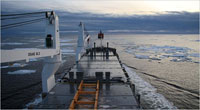 We have been following the progress of Beluga Shipping in their attempt to make a commercial transit of the “Northern Sea Route” which is also referred to as the “North East Passage.” See our “Beluga Group attempts the Northern Sea Route” and “Arctic Waters are Getting Busier“.
We have been following the progress of Beluga Shipping in their attempt to make a commercial transit of the “Northern Sea Route” which is also referred to as the “North East Passage.” See our “Beluga Group attempts the Northern Sea Route” and “Arctic Waters are Getting Busier“.
Captain D. Peter Boucher has a great update on Beluga’s progress on the Nautical Log Blog , in his post, North East Passage , as does yesterday’s New York Times, Arctic Shortcut Beckons Shippers as Ice Thaws.
Continue reading

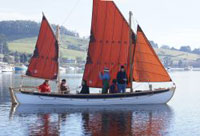 Australian adventurer Don McIntyre and teenage circumnavigator Mike Perham to re-enact Capt William Bligh’s epic mutiny on the Bounty open boat voyage
Australian adventurer Don McIntyre and teenage circumnavigator Mike Perham to re-enact Capt William Bligh’s epic mutiny on the Bounty open boat voyage